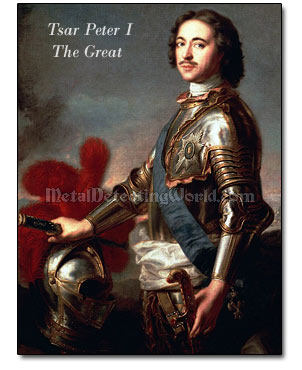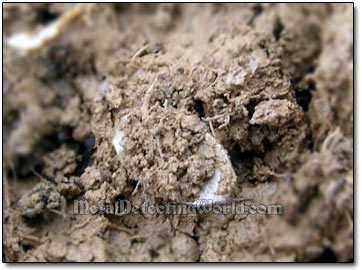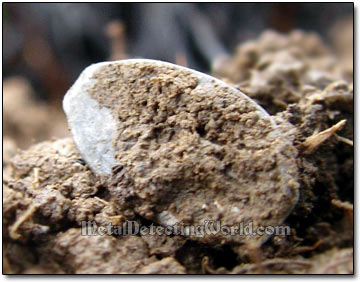Part II - Detecting at the Virgin Site of Tavern, page 67
A Few Words on Successful Monetary Reform of Peter I The Great, 1698-1724

Peter I Alekseevich Romanov (1672-1725) was the Russian Tsar from 1686 to 1725 and Russian Emperor from 1721 to 1725. Peter I was one of the most outstanding state figures in the worlds history for his achievements in founding and building the Russian Empire through the most effective and innovative reforms, and setting a 3-billion acre country on a course of rapid developments in economy, science, military and society.
He faced much opposition to his policies in Russia, but brutally suppressed all rebellions against his authority. Peter's sweeping reforms aimed at modernizing and westernizing Russia and making it a major European and maritime power.
One of his great achievements was his successful reforming of the old Russian monetary system. As building Russia's navy and modernizing Russian army required substantial funds, Peter decided to replace silver coinage with less expensive copper specie. And he could do this through his monetary reform which would allow him to generate big revenues and put them into his major state projects.
Peter's reform was well-designed, explicitly planned and gradually executed to let common people get used to the idea of copper money, new monetary system and new chronology.
At the preparatory stage in 1696, Peter started issuing dated silver wire kopecks to prepare people to the coming changes in the monetary system. Also, the production of money was brought to a new technological level - mechanical coining. A few new mints had been built in Moscow by 1700 when minting of small copper coins began; the mintage quantities gradually increasing.
In 1699, Peter changed the celebration of the New Year from September 1 to January 1. Traditionally, the years were counted from the "Creation of the World", but after January 1, 1700, they were to be counted from the "Birth of Christ". Thus, when the Julian calendar was proclaimed to be in effect, the new era chronology commenced. Peter was the first ruler in the world to implement a decimal monetary system, and, in 1704, the first silver Rouble coin appeared. Now 1 Rouble equaled 100 Kopecks, and these two denominations were taken as a basis of the new monetary system.
Gradual introduction of the copper money had earned people's trust in copper coins. The simultaneous issuance of uniformly dated silver and copper kopecks had accustomed people to the equality between the "old" and "new" coins of the same denomination. While being in simultaneous circulation alongside the copper kopeck for 13 years, the silver wire kopeck functioned as "transitional" and laid out the success of Peter's reform. The manual hammering of silver wire kopecks was terminated in 1717. The modern coin catalogues give a year of 1718 as the end-year for the wire coin production, but the only existing 1718 wire kopeck has been recently proved to be a fake.
Although debasement of coinage and tax reform also added big revenues to the state budget, the monetary reform had fulfilled its tasks. And it greatly contributed to Russia's success in the Great Northern War (1700-1721, also "Third Northern War") which ended with Russia's regaining a huge province of Ingermanland with the Baltic Sea ports. Peter's reform allowed him to generate enough money for founding and building the most beautiful city in Russia - St. Petersburg. In 1721, Peter made it Russia's capital. Peter's foundation of the St. Petersburg Mint marked the end of his successful monetary reform.
To see images of representative specimens that were minted under several rulers in Russia from 1478 to 1701, detailed descriptions of the wire coins' obverses and reverses, and the exact transcription of coins' legends inscribed in old cyrillic letters, please visit my Photo Gallery of Russian Medieval Hammered Coins - Wire Money.
Discovery of a hammered coin really was a "wake-up call" for me. Now the thoughts and ideas were streaming into my mind. First, I realized that by having been oblivious to existence of hammered coins at the tavern sites and spots similar to them, I had deprived myself of an opportunity to unearth the oldest coinage. Second, this small discovery had exposed the urgency of revision of my metal detecting tactics. Most likely, changing my tactical approach would "open new doors" for me. After all, one small discovery put my metal detecting quest on a new course of action for the rest of the detecting season.
At that moment, I had a new plan: to hit other krog locations, which had been previously visited by me and my friends, and look specifically for silver hammered coins. As if to eliminate my last doubt about my new plan, another silver wire appeared in dirt!

As I was back on track in terms of being 100% confident and full of mental strength, I resumed my thinking about the idea of a "human-detector" existing in every one of us.
...Before you imagine a coin that you wish to find at the metal detecting site, learn the local history to determine what coins might be found in your area, and whether or not this coin might be present among them. Then obtain a coin catalogue and familiarize yourself with the coin's characteristics: size, metal, obverse and reverse designs, varieties, key dates, and whatever else may help you visualize the specimen. This would be a realistic approach. "He who sees, knows; he who sees not, knows not."
